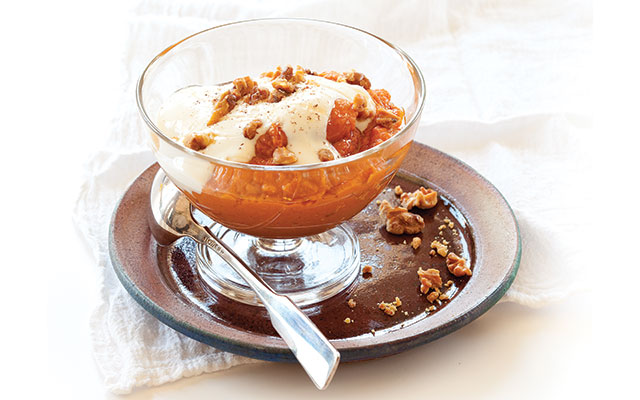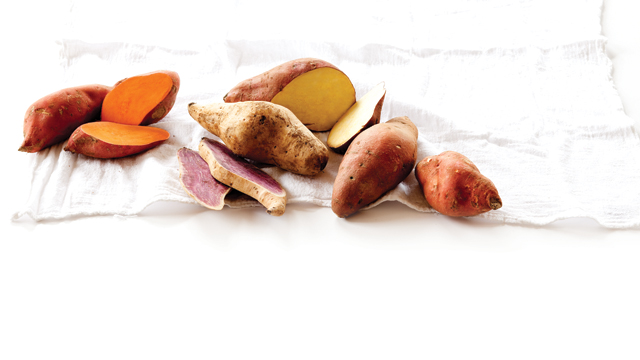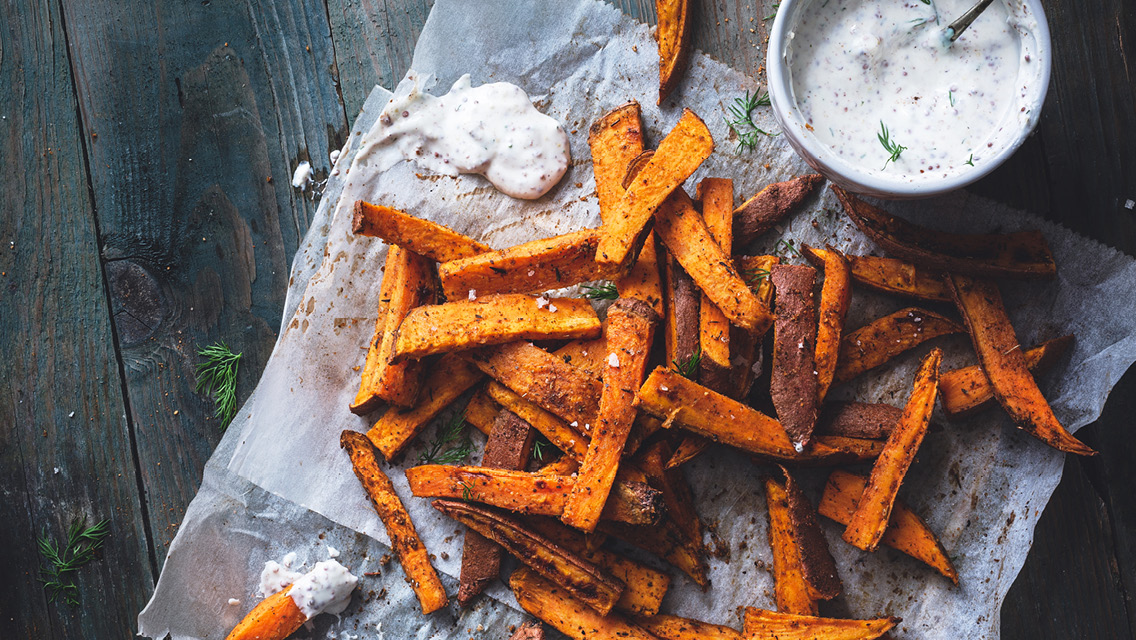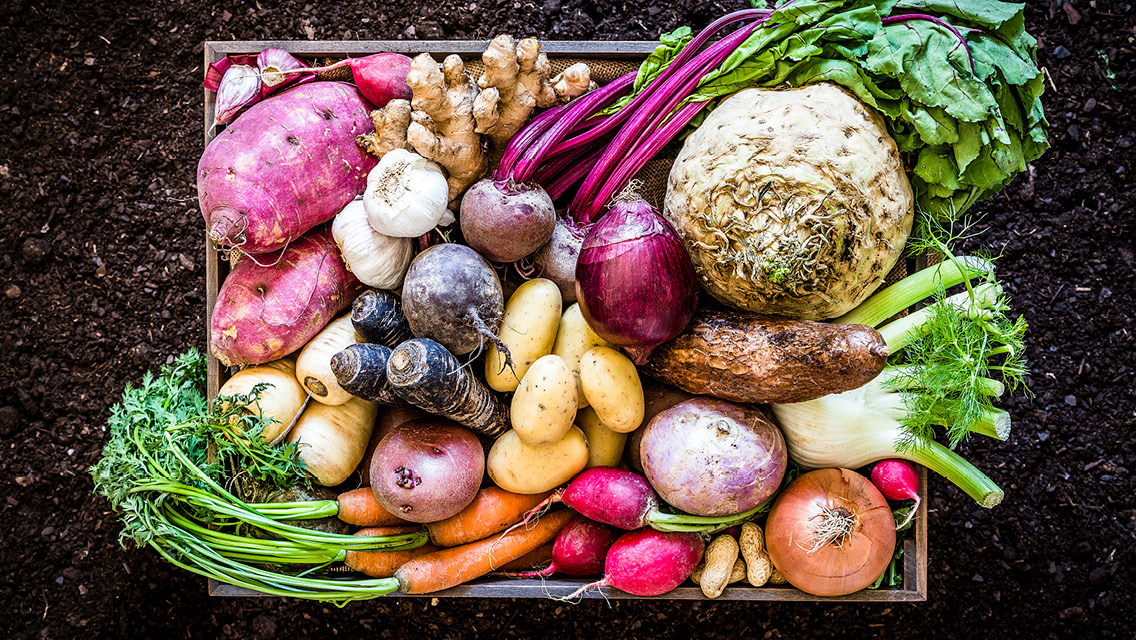Most people get introduced to sweet potatoes when they’re kids — usually during the holidays, often served mashed or in a casserole, and sometimes festooned with marshmallow creme. For many, a holiday dinner devoid of sweet potatoes would be like an empty Christmas stocking. But that doesn’t mean you should save their rich flavor and comforting presence for one or two annual traditions.
Study after study shows that sweet potatoes are one of the healthiest foods on the planet. Their beautiful orange pigment is the result of powerful, disease-fighting flavonoids, and they’re packed with healthy fiber. But there are other good reasons to make sweet potatoes part of your regular vegetable rotation. They’re inexpensive and simple to prepare, and because they can be served sweet or savory, they can be easily integrated into all kinds of menus.
Here you’ll find quick and easy cooking ideas, plus hearty, main-course recipes that use sweet potatoes in untraditional, creative ways. Great for the holidays — or any time this season.
Nutrition Know-How
- Many people know that sweet potatoes are high in beta-carotene, but few know that you need to have some fat with your meal in order to absorb the beta-carotene. A minimum of 3 to 5 grams of fat, or about 1 teaspoon of extra-virgin olive oil, does the trick.
- Anthocyanins are a flavonoid that give sweet potatoes their vibrant orange — and sometimes purple — color. They contain great antioxidant and anti-inflammatory properties. Steaming sweet potatoes for seven minutes, or even as little as two minutes, maximizes their nutritional value by deactivating the enzymes that would otherwise break down anthocyanins.
- Even though the word “sweet” is in its name, sweet potatoes are actually a good food for diabetics because they help stabilize blood-sugar levels. They do so not only with dietary fiber, but also by increasing blood levels of the protein hormone adiponectin — which modifies insulin metabolism — in people with type 2 diabetes.
Kitchen Tricks
- Feel free to eat and enjoy the skin of organically grown sweet potatoes. If the tubers have been conventionally grown, make sure to peel the skins before steaming and roasting, or after baking; in addition to chemicals, the skins may contain wax or dye.
- Cut sweet potatoes into consistently sized slices or cubes so they’ll cook evenly.
- As soon as they are cut or peeled, raw sweet potatoes begin to darken. Cook them immediately or keep them covered in water until you’re ready to use them.
Shopping and Storage Tips
- Look for sweet potatoes with smooth skin, deep color and few bruises.
- Select size based on intended preparation. Chef Terry chooses larger sweet potatoes if he wants consistently sized rounds. If he’s going to dice or purée them, a mix of sizes is fine.
- Store sweet potatoes in a cool, dark, dry place (such as a pantry) that’s not too close to the oven. Do not store in plastic bags or covered containers, which encourage rot. Instead, keep sweet potatoes in a paper bag with several holes in it, or in a wicker basket.
What Is the Difference Between a Yam and a Sweet Potatoe?
Ever wonder about the difference between sweet potatoes and yams? Our grocery stores generally divide two similar-looking tubers into two bins: One contains the firm, white “sweet potato” and the other has “garnet yams” or “jewel yams,” whose flesh is more moist and orange.
But we’re the only country in the world to call those vegetables “yams.” They are actually sweet potatoes, too.
True yams — what Americans call “tropical yams”— are generally starchier and less flavorful than sweet potatoes. They’re long and cylindrical and can weigh from a few ounces to 120 pounds. More than 200 varieties are grown worldwide.
But here in the United States, unless you’re shopping at an African,Caribbean or Asian food market, you’re probably buying sweet potatoes. Sweet potatoes come in about 400 varieties, in many shapes and sizes, and can have orange, cream, red or purple flesh. They range in flavor, texture and sweetness. You can find heirloom varieties like Carver, Frazier White, Georgia Jet, Hernandez, Korean Purple and Vardaman at farmers’ markets — or you can grow them yourself from seed.
Here’s what really matters: Whatever they’re called, most American-style yams and sweet potatoes can be substituted for each other in most recipes.
Quick and Easy
1. Steamed: The best way to preserve sweet potatoes’ nutrients. Steam them sliced or cubed, skins on or off. Serve with olive oil, maple syrup or a favorite topping. Try them chilled in salads.
2. Baked: Instead of baking a russet potato, try a sweet potato. Wash, prick in a few places with a knife, and bake at 350 degrees F for about 45 minutes, until main-course fare by topping with creative combos: diced grilled chicken breast, broccoli and a little sharp cheddar cheese; curried tempeh and veggies; ground turkey or pork cooked with ginger and miso, sprinkled with chopped roasted peanuts and green onions.
3. Roasted: Cut into even-size spears or chunks, toss with a little extra-virgin olive oil and sea salt, then roast at 425 degrees F for about an hour, tossing every 15 minutes. For a healthy alternative to French-fried potatoes, cut two sweet potatoes lengthwise into ½-inch slabs, and then cut the slabs into ½-inch strips; roast on a baking sheet drizzled with coconut oil or olive oil, and sprinkled with sea salt. Roasting diced sweet potatoes with other root vegetables makes a gorgeous, hearty winter salad.
4. Mashed: For a comforting side dish, steam or bake whole sweet potatoes, then mash as you would russet potatoes. (For a flavor punch, take a tip from Chef Bryant Terry, and replace milk with coconut milk.) For a tasty dip, combine mashed sweet potatoes with Greek yogurt.
5. Puréed: Silky puréed sweet potato can be added to many dishes, including smoothies and soups. Mix sweet potato purée with pressed garlic, cayenne, lemon juice and extra-virgin olive oil for a flavorful dip. A smoothie of coconut milk,orange juice and sweetpotato with a little pumpkin pie spice is fantastic.
Sweet Potato Recipes
Sweet Potato and Pork Green Curry Stew
Sweet potatoes add a contrasting sweetness to spicy green curry. You can substitute chicken, shrimp or tofu for the pork.

Serves four to six
Directions
• 1 tbs. coconut oil
• 2 to 6 tbs. green curry paste (depending on how hot you like it)
• ½ cup yellow onion, thinly sliced
• ½ pound pork tenderloin, cut into 1-inch cubes
• 2 medium sweet potatoes, peeled and cut into 1-inch chunks
• 2 cans coconut milk
• 2 cups green beans, cut into 1-inch pieces
• ½ cup chopped Thai basil
• Lime wedges
Directions
- In a large saucepan, heat coconut oil and curry paste until fragrant. Add onions and pork, and sauté until the pork is cooked through.
- Then add the sweet potato and cook five minutes, covered, stirring every couple of minutes.
- Add coconut milk and bring to a low simmer.
- Cover and cook, stirring occasionally, until sweet potatoes are tender (about five to seven minutes).
- Add green beans and cook for another five to seven minutes.
- Garnish with chopped fresh Thai basil and lime wedges.
Sweet Potato and Collard Greens Salad
Quick to prepare, this combination of superfoods makes a colorful side dish. You can substitute Swiss chard, spinach or kale for the collards.

Serves six to eight
Ingredients
• 2 sweet potatoes, peeled and cubed (about 3 cups)
• 2 tbs. olive oil
• 1/2 tsp. sea salt
• 1/4 tsp. fresh ground pepper
• 1 bunch collard greens, chopped (about 4 to 5 cups)
• 1/2 cup roasted pumpkin seeds
• 1/4 cup dried cherries
• Zest and juice of one lemon
• 1 tbs. coarse ground mustard
• 1 tbs. pumpkin seed oil or olive oil
Directions
- Toss sweet potatoes with olive oil, salt and pepper, and roast at 375 degrees F on a baking sheet for 25 to 30 minutes.
- Remove from oven and toss collards with sweet potatoes directly on the hot baking sheet, then return to the oven for another five minutes until the greens begin to wilt.
- Transfer greens and sweet potatoes into a bowl and mix with pumpkin seeds, dried cherries and lemon zest.
- In a separate bowl, whisk the lemon juice, mustard and pumpkin seed oil together, then toss with the salad.
- Enjoy at room temperature immediately, or refrigerate until serving.
Bryant Terry’s Molasses, Miso and Maple Candied Sweet Potatoes

Serves four to six
Ingredients
• 2 1/2 pounds sweet potatoes or garnet yams), peeled and cut into 1/2–inch rounds
• 2 tbs. toasted sesame oil
• 1 (2-inch) cinnamon stick
• 2 tbs. molasses
• 1 tsp. tamari or shoyu
• 2 tbs. pure maple syrup
• 1 heaping tbs. white or yellow miso
• 1/4 cup freshly squeezed orange juice
• 1 tbs. freshly squeezed lemon juice
• 1/4 tsp. grated lemon zest
• 6 tbs. filtered water
Directions
- Preheat the oven to 425 °F.
- In a large bowl, toss the yams with 1 tablespoon of the sesame oil. Spread the yams on a parchment-lined or well-greased baking sheet in a single layer and roast for 50 minutes, turning over with a fork after 25 minutes.
- Remove the yams from the oven and lower the heat to 375°F.
- Place the cinnamon stick at the bottom of a 2-quart baking dish, and add the yams in layers. Set aside.
- In a medium-size bowl, whisk together the molasses, tamari, maple syrup, miso, orange juice, lemon juice, lemon zest, water, and the remaining tablespoon of sesame oil. Pour over the yams.
- Bake, uncovered, for 30 minutes, thoroughly basting the sweet potatoes every 10 minutes.
Steamed Sweet Potatoes With Tamari Ginger Sauce
Steaming is a quick and healthful way to prepare sweet potatoes. This side dish is especially nice accompanied by buckwheat or Soba noodles and grilled meat or tofu.

Serves four
Ingredients
• 3 sweet potatoes, cut crosswise into ¾-inch thick slices
• Juice of one orange
• 1 tbs. tamari
• 1/2 tsp. fresh grated ginger root
Directions
- Slice sweet potatoes and place in a single layer in a steamer basket.
- Steam over simmering water for 10 to 15 minutes, until just tender.
- Mix the orange juice, tamari and ginger root together in a small bowl.
- Drizzle sauce over the steamed sweet potato slices and serve hot, at room temperature, or chilled.
Sweet Potato Mousse with Maple Vanilla Yogurt and Walnuts
While naturally sweet, this rich and creamy dessert contains surprisingly little sugar — and can be enjoyed warm or cold.

Serves four
Ingredients
• 1 tsp. freshly grated gingerroot
• 1/2 tsp. pumpkin pie spice
• 2 cups sweet potato purée (to make, purée roasted, peeled sweet potatoes in a food processor)
• 1 tbs. plus 1 tsp. maple syrup
• 1/2 tsp. vanilla extract
• 3/4 cup plain Greek yogurt
• 1/2 cup chopped roasted walnuts
• Freshly grated nutmeg
Directions
- Stir the gingerroot and pumpkin pie spice into the sweet potato purée.
- Divide the sweet potato mixture into four dessert dishes.
- Mix 1 teaspoon maple syrup and the vanilla extract into the yogurt.
- Drizzle each dish with some of the yogurt mixture and the remaining 1 tablespoon of maple syrup, then sprinkle with chopped walnuts and freshly grated nutmeg.
- Enjoy at room temperature or chilled.
A Twist on the Traditional
An interview with Chef Bryan Terry
Chef Bryant Terry is no stranger to the sweet potato. His family grew them on rural farms in Tennessee and Mississippi, and his paternal grandfather grew them in his backyard urban farm in Memphis, where Terry grew up. For his family, sweet potatoes were part of a larger family tradition: growing natural, organic, fresh food; cooking it together; and enjoying meals with friends in the community.
The author of three cookbooks, Terry now lives in Oakland, Calif., and describes himself as a food activist. His mission: “To create access to healthy, safe, affordable food for everyone.” And sweet potatoes? They’re still a valued part of his food repertoire.
Terry’s third cookbook, The Inspired Vegan: Seasonal Ingredients, Creative Recipes and Mouth-Watering Menus (Da Capo, 2012), is due out this winter.
EL What do really good sweet potatoes taste like?
BT Sweet potatoes are just a little starchy and have an equal balance of earthiness and delicate sweetness. So many people have misconceptions about healthy food and fresh food — that it’s bland, and it’s boring, and it’s not going to taste good. The problem is that most people are used to consuming vegetables that have been mass produced and shipped across the country, or have been sitting in warehouses for weeks or months on end. By the time sweet potatoes actually get to consumers, they often have very little flavor. Beyond environmental and health concerns, that’s one more reason to seek out sustainably or locally grown sweet potatoes whenever possible: They taste a lot better.
EL When is the best time to enjoy sweet potatoes?
BT Their peak season is in the late fall going into the winter. I would suggest that people follow that natural rhythm and enjoy sweet potatoes then. That’s when you’re going to get the most flavor. It’s important for us as modern eaters to get back into the practice of eating what’s in season and really trust the inherent brilliance of the earth.
EL Is there anything unusual you do when cooking sweet potatoes?
BT My latest dish, in my new book, is Molasses, Miso and Maple Candied Sweet Potatoes. (See web extra.) It’s a twist on the traditional candied sweet potatoes. Molasses is a staple that is used throughout the South. Miso gives this dish earthy, savory saltiness. Then, a little maple syrup adds a bit more sweetness.
EL What’s your earliest sweet potato memory?
BT Sweet potatoes were always abundant in our house. My earliest memory is of my paternal grandfather preparing them in the oven, wrapped in aluminum foil, and roasted on high heat. He would split them open and add a pat of butter. They were very, very simple. As far as I’m concerned, that’s as straight and honest a sweet potato as you can get.
This article originally appeared as “Earthy Goods” in the December 2011 issue of Experience Life.



This Post Has 0 Comments